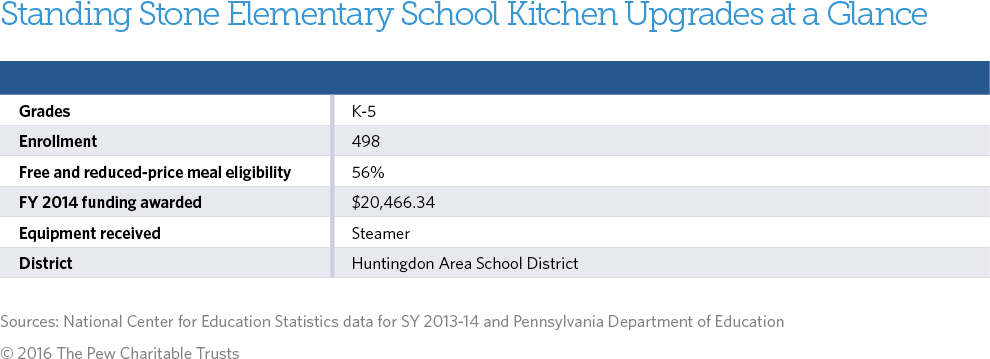Standing Stone Elementary School
Huntingdon, Pennsylvania
In the cafeteria at Standing Stone Elementary in Pennsylvania’s Huntingdon Area School District, kids raised on farms sit with peers whose parents work at nearby colleges and correctional facilities. Food Service Director Peg McNitt and her staff strive to make the lunchroom a place where every student can feel at ease and enjoy the nutritious food that all children need.
McNitt and other district leaders know that providing healthy, delicious meals and snacks depends in part on having reliable and efficient kitchens, and they do their best to budget for needed upgrades. But funds can be tight, so she jumped at the chance to apply for a U.S. Department of Agriculture equipment grant to replace Standing Stone’s steamer, which frequently malfunctioned and forced staff to change menu plans on the fly.
The new steamer’s larger size, greater versatility, and faster cooking speed save the meal program time and energy costs in preparation of foods ranging from vegetables to eggs to pasta. Students’ dishes are fresher, because the staff can quickly complete large batches close to mealtime. As a result, steamed produce has better taste, color, and texture while meats come out moist and tender because they do not get overcooked as they did in the old unit.
Thanks to the improved food quality, children are eating more vegetables, and the nutrition team has been able to make recipes even healthier. For example, staff can prepare appetizing favorites such as macaroni and cheese and stewed tomatoes with less salt, because the steamer preserves more of the foods’ natural flavors. “The tomatoes turn out better than ever,” McNitt says. “And we no longer worry about our steamer not firing up in the morning or how much the repair bill will be.” In coming months, she hopes to work with administrators to build on these successes and further enhance kids’ enjoyment of their food by extending lunch periods and scheduling recess before, rather than after lunch, a strategy shown to increase children’s consumption of fruits and vegetables.1

End Notes
- Joseph Price and David R. Just, “Lunch, Recess and Nutrition: Responding to Time Incentives in the Cafeteria,” Preventive Medicine 71 (2015) 27–30, doi: 10.1016/j.ypmed.2014.11.016.






